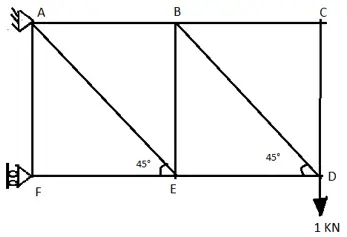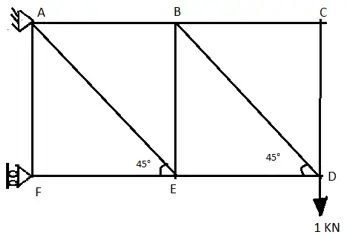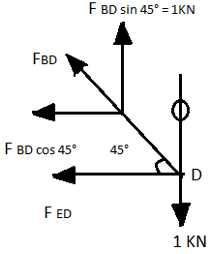1. Which of the following is not a valid assumption in analysis of truss?
a) Members are subjected to axial forces only
b) Loads and reactions will act directly or indirectly at the members only
c) Member varies linearly only
d) All joints are smooth and frictionless hinges
Explanation: The basic assumption for truss analysis are as follows:
- Members are subjected to axial forces only
- Loads and reactions will act directly or indirectly at the joints only
- Member varies linearly only
- All joints are smooth and frictionless hinges.
2. Self-weight of members are ignored in truss analysis.
a) True
b) False
Explanation: As compared to external forces acting on trusses, self-weight of the member is negligible and hence ignored for analytic purpose.
3. Which of the following is not true for the method of joints?
a) Equilibrium of joints is considered in method of joints
b) Number of equilibrium equations are 2 for method of joints
c) Method of joints can be used to solve for up to 3 unknowns at a joint
d) Forces in prior member are to be calculated first, for calculating internal forces in any chosen member
Explanation: Method of joints can be used to solve for up to 2 unknowns at a joint as we have only 2 equilibrium equations.
4. Calculate the force in member BC.
a) 1KN (COMPRESSIVE)
b) 1KN (TENSILE)
c) \(\sqrt{2}\) KN (TENSILE)
d) 0KN
Explanation: By observing the member BC and member CD, it is not acted upon by any form of external forces, thus zero force is introduced into them. Thus, member BC and member CD are zero forces member.
5. Find the force in member ED?
a) 1KN (COMPRESSIVE)
b) 1KN (TENSILE)
c) \(\sqrt{2}\) KN (TENSILE)
d) 0KN
Explanation: As from the shown figure at joint D, member CD is carrying zero force. Therefore, at joint D to balance the vertical force. FBDsin45° = 1KN. Thus, FBD = \(\sqrt{2}\) KN and FBD sin 45° = 1KN. To balance horizontal reaction FBD

cos45° = FED 1KN (Compressive).
6. Find the force in member BD?
a) 1KN (COMPRESSIVE)
b) 1KN (TENSILE)
c) \(\sqrt{2}\) KN (TENSILE)
d) 0KN
Explanation: As from the shown figure at joint D, member CD is carrying zero force. Therefore, at

joint D to balance the vertical force. FBDsin45° = 1KN. Thus, FBD = \(\sqrt{2}\) KN.
7. Find the force in member AF?
a) 1 KN (COMPRESSIVE)
b) 1KN (TENSILE)
c) \(\sqrt{2}\) KN (TENSILE)
d) 0KN
Explanation: At End F, only one reaction is produced in the direction collinear with FFE. Therefore by forces member analysis. Force in member FC will be zero.
8. Calculate force in member FE.
a) 1KN (COMPRESSIVE)
b) 1KN (TENSILE)
c) 2KN (COMPRESSIVE)
d) 0KN
Explanation: Taking Moment about point A. ∑A = 0, 1*2x – X*x=0, Thus, X = 2. For balancing horizontal force at joint F. FFE = 2KN.
9. Zero Force Members can be removed from structure.
a) True
b) False
Explanation: Zero force members cannot be removed from structure. Although they do not carry any forces but they effective in maintaining stability.
10. Identify incorrect statement about truss analysis.
a) Zero force may should not be removed from structure
b) Method of joint enables us to solve any kind of truss analysis problem
c) Method of section enables us to solve any kind of truss analysis problem
d) Pin joint plane frame has 2 equilibrium equation at joint
Explanation: Method of joint has it’s limitation that it only solve the joints which have less than or equal to 2 unknown forces. Thus, it cannot solve any kind of truss analysis problem.